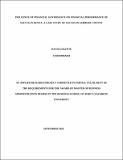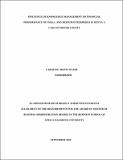| dc.description.abstract | SACCO sector comprise of more than half of cooperatives in Kenya which are found in almost all sectors of the economy, about 80% the Kenya populations drive their income from this initiative. The SACCO movement is categories into, the traditional saving and credit cooperative societies which are non-deposits and deposit taking (DTS).The problem of financial governance exist for all SACCOs in Kenya. It has existed for a long period of time given that they act as intermediaries of between saver and borrowers. Number of cooperative societies in Kenya have substantially increased and equally spread across urban and rural areas due to their contribution to members. The study’s main objective was to find out influence of financial governance on financial performance of SACCOs in Samburu County, the study specific objectives were, to examine the influence of capital adequacy on financial performance of SACCOs, to find out influence of credit lending on financial performance of SACCOs, to establish the influence of liquidity management on financial performance. The study reviewed theories that are related to the study, the theories are, agency, shift Ability, organization and Q-theory of investment. A random sample of 30 SACCOs from the population 64 in Samburu County were taken. Questionnaire was used as tool for data collection by the researcher. Data that was collected was coded and then analyzed using descriptive statistics. A descriptive statistic model of the return on investment, profitability and growth of asset versus, capital adequacy, liquidity management and credit lending was tabulated to check the relationship between the variable. Majority of respondents agreed that capital is a requirement only few did not agree. Minimum capital required by SACCOs is 10-35% against total asset, 79.2% of the respondents agreed that capital adequacy influence SACCO financial performance.95% of the respondents indicated that there are bylaws in place that govern credit lending activities .41.7% of respondent also indicate credit lending has high influence on SACCO financial performance while only 4.2% indicate it has low influence.96% of the respondents agreed that liquidity management influence SACCOs financial performance. All the three independent variables are significant in predicting financial performance. However, liquidity management (β=0.388, p<.000) (β=0.497p<.000) has high significant influence on financial performance on both return on investment and growth of asset respectively, credit lending ( β=0.351 p<.000). The study was achieved by seeking answers to three research questions which addressed study objectives. The researcher carried out census survey of 30 SACCOs of 64 targeted. It was established that thought credit lending and capital adequacy had a role to play in the attainment of SACCO financial performance, liquidity management was seen to have a higher influence on the financial performance of SACCOs. A SACCO should at list maintain a minimum capital adequacy that is required by SASRA. | en_US |



